I purchased a pair of ML Sequels II recently for $160.00 knowing that they did not work properly hoping that I could fix them. I heard these a few times and have always loved them. I was not able to audition the speakers prior to buying but look good on exterior inspection...woofers fine, membrane had no rips and looked pretty clean. when I got home, I plugged them in and only heard sound from the woofers. I waited a few hours and looked inside the back metal plate with the electronics...very dusty and what looked like several burned areas (see pics). As I researched these on this forum, I notice that a couple of you recommended some cap upgrades/mods. Thinking I had nothing to lose, I ordered the caps and replaced them according to the step-step instructions. I then tried them again and no more sound came from the panels. I will be calling ML directly soon but am afraid that replacing panels and/or electronics may be more expensive than I would like to pay, I have and additional $100 in caps into these already. While I know understand that the mylar membrane made need cleaning or replacement due to coating wearing off, I should hear some sound. This makes me believe that I'm missing something. The back plate is separated into two sections (crossover with transformer and possibly a power supply section)??? While I have very little experience with electronics, I'm wiling to learn. I understand that the panels need current in order to work which makes me think that the power supply part is not working??? need help/suggestions.
Attachments
-
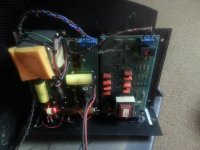 20131028_150351_resized_2.jpg605.9 KB · Views: 1,321
20131028_150351_resized_2.jpg605.9 KB · Views: 1,321 -
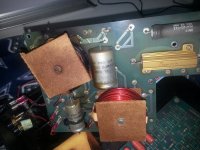 20131101_130533_resized_1.jpg737.9 KB · Views: 807
20131101_130533_resized_1.jpg737.9 KB · Views: 807 -
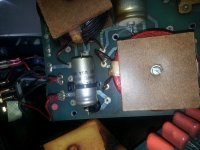 20131101_130542_resized_2.jpg621.3 KB · Views: 489
20131101_130542_resized_2.jpg621.3 KB · Views: 489 -
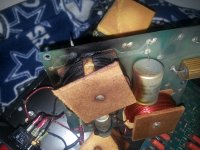 20131101_130553_resized_2.jpg671.8 KB · Views: 495
20131101_130553_resized_2.jpg671.8 KB · Views: 495 -
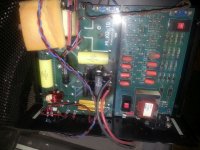 20131028_151332_resized_2.jpg668.7 KB · Views: 494
20131028_151332_resized_2.jpg668.7 KB · Views: 494 -
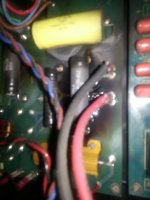 20131028_151322_resized_3.jpg440.8 KB · Views: 519
20131028_151322_resized_3.jpg440.8 KB · Views: 519 -
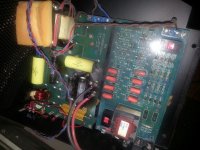 20131028_151306_resized_1.jpg654.5 KB · Views: 869
20131028_151306_resized_1.jpg654.5 KB · Views: 869 -
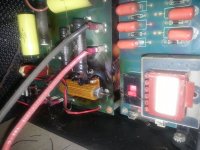 20131028_150407_resized_3.jpg607 KB · Views: 958
20131028_150407_resized_3.jpg607 KB · Views: 958 -
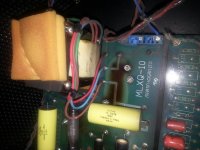 20131028_150415_resized_1.jpg602.8 KB · Views: 964
20131028_150415_resized_1.jpg602.8 KB · Views: 964 -
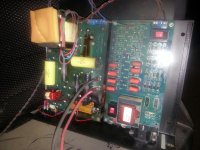 20131028_150428_resized_1.jpg614.9 KB · Views: 987
20131028_150428_resized_1.jpg614.9 KB · Views: 987
Looks like the bias is out............if there is No bias... all parts well cook....an get vary HOt..like yours look!
Any amp can be driven into clipping.........to the amp...with out bias.. it looks all most like a dead short!
you need to start cking the res....see how far off sec thay are....but with out bias the panels well no work.......... or make sound......
.this is the only setup pic i have.
Any amp can be driven into clipping.........to the amp...with out bias.. it looks all most like a dead short!
you need to start cking the res....see how far off sec thay are....but with out bias the panels well no work.......... or make sound......
.this is the only setup pic i have.
Attachments
Tyu, is there an easy way to test and fix the bias? I see your schematic but I do not understand it. I have a multimeter that could help. Also, I know that it is dangerous as these put out high voltage when plugged in and working properly. Lastly, maybe just replacing it is the answer. ..ML quoted me at least $300 each and wondering if there is an alternative replacement. Please advise. Thanks.
Well...........you woluld have over $700............i bet thay need new panels...i have had 6-7 pr of ML here..........
Aerius i.......SL3pr...........Cls ......... Qest..Prod...an Ascent i...
All newer than yours.............an thay all need panel work.....ML well wont too get from $15-1900..........for new panels........
I think your money may be better sent on a used pr of ML you can play an see if you like the sound for less than a grand...........
As for adding a new bias............Russ KnottsJust Real Music....sales a bias........For less $$ like $150 for the pr are less....1.9-5k bias v... an he also reworks Ml panels....get the bias up an than see how the panls sound.
let us know what you do............
ESL Electronics
Aerius i.......SL3pr...........Cls ......... Qest..Prod...an Ascent i...
All newer than yours.............an thay all need panel work.....ML well wont too get from $15-1900..........for new panels........
I think your money may be better sent on a used pr of ML you can play an see if you like the sound for less than a grand...........
As for adding a new bias............Russ KnottsJust Real Music....sales a bias........For less $$ like $150 for the pr are less....1.9-5k bias v... an he also reworks Ml panels....get the bias up an than see how the panls sound.
let us know what you do............
ESL Electronics
Attachments
DO NOT attempt to repair the electronics modules if you don't know exactly what you are doing. There are lethally high voltages involved. I think your safe choices are to either buy new modules from Martin-Logan, or have those bad modules repaired by a competent service shop, or minimize your loss by selling them and moving on to different speakers.
I once owned a pair of Sequel IIs. They looked great, had great sound clarity, and generated a huge soundstage. Unfortunately, they also had what I experienced as three serious tonal flaws. One was an apparent deficit in energy through the lower midrange, making the overall tonal balance sound thin or cold. Another was an upper midrange through lower treble that sounded too brilliant or bright. Lastly, there seemed to be a very slightly soft or rolled-off high treble. I feel that the lower and upper midrange problems were largely the fault of the crossover design. Simply inverting the polarity of the woofer leads ameliorated, but didn't fully correct, the thin or cold quality. The bright upper midrange problem was probably largely due to uncorrected dipole cancellation of the electrostatic panel, for which a higher than 250Hz crossover point could have helped to minimize.
I variously powered them with a pair of Audio Research M120 tube monoblocks, and later with an 200W/ch. Forte' solid-state stereo amp. Neither amp could redeem them. Finally, I sold them because I found that for all their sound virtues and cool factor, I couldn't continue to live with their tonal problems.
I once owned a pair of Sequel IIs. They looked great, had great sound clarity, and generated a huge soundstage. Unfortunately, they also had what I experienced as three serious tonal flaws. One was an apparent deficit in energy through the lower midrange, making the overall tonal balance sound thin or cold. Another was an upper midrange through lower treble that sounded too brilliant or bright. Lastly, there seemed to be a very slightly soft or rolled-off high treble. I feel that the lower and upper midrange problems were largely the fault of the crossover design. Simply inverting the polarity of the woofer leads ameliorated, but didn't fully correct, the thin or cold quality. The bright upper midrange problem was probably largely due to uncorrected dipole cancellation of the electrostatic panel, for which a higher than 250Hz crossover point could have helped to minimize.
I variously powered them with a pair of Audio Research M120 tube monoblocks, and later with an 200W/ch. Forte' solid-state stereo amp. Neither amp could redeem them. Finally, I sold them because I found that for all their sound virtues and cool factor, I couldn't continue to live with their tonal problems.
Last edited:
Ken
Thanks for the advice. ..Tyu suggesed a person in Ohio who works on these who believes that it is more likely a panel issue and not a bias problem. Either way, he fixes these panels with a proprietary coating which should last longer than the original coating ML had on them. He charges $400 for a pair and he said that he would look/fix the electronics for free. So, I originally bought them for $160 +$100 in caps + a possible $400 for panels =$660. Are they worth it. ...I'm not sure, as I certainly did not sign up for this much of an expense. Even so, I believe that a good used paid is about $1000 these days and I should have something close to new by the end. I have heard the sequel iis paired with an Aragon MKII and the were incredible. ..dynamic, clear and very resposive. I'm not sure if I'm simply trying to remedy a mistake or that I really enjoyed their sound....possiby a little of both. Thoughts anyone?
Thanks for the advice. ..Tyu suggesed a person in Ohio who works on these who believes that it is more likely a panel issue and not a bias problem. Either way, he fixes these panels with a proprietary coating which should last longer than the original coating ML had on them. He charges $400 for a pair and he said that he would look/fix the electronics for free. So, I originally bought them for $160 +$100 in caps + a possible $400 for panels =$660. Are they worth it. ...I'm not sure, as I certainly did not sign up for this much of an expense. Even so, I believe that a good used paid is about $1000 these days and I should have something close to new by the end. I have heard the sequel iis paired with an Aragon MKII and the were incredible. ..dynamic, clear and very resposive. I'm not sure if I'm simply trying to remedy a mistake or that I really enjoyed their sound....possiby a little of both. Thoughts anyone?
I have about the same experience with my SL3's as Ken has with his 2's.
I have Krell monoblocks 100/100 and 150/150's that drive them very well, but the krell 50 watter just doesn,t cut it with these. The RM 9 with kt88s was a decent match.
No mater what you drive them with their basic nature is one of unbalance as Ken found out.
Its easy to say the woofer is mismatched and on the surface of things, but theres more to it than that I believe, and this has been noted by more than a few reviewers, its just a threadbare presentation.
What would be a nice rebuild would be some Scanspeak 7" line arrays at maybe 300 hz 6db to panel with 6db 5k or 4k 6db to a line ribbon the same height because that panel starts rolling off at 10k..
You might get a nice impulse response if everything is lined up right and would keep the panel out of its problem areas.
Regards
David
I have Krell monoblocks 100/100 and 150/150's that drive them very well, but the krell 50 watter just doesn,t cut it with these. The RM 9 with kt88s was a decent match.
No mater what you drive them with their basic nature is one of unbalance as Ken found out.
Its easy to say the woofer is mismatched and on the surface of things, but theres more to it than that I believe, and this has been noted by more than a few reviewers, its just a threadbare presentation.
What would be a nice rebuild would be some Scanspeak 7" line arrays at maybe 300 hz 6db to panel with 6db 5k or 4k 6db to a line ribbon the same height because that panel starts rolling off at 10k..
You might get a nice impulse response if everything is lined up right and would keep the panel out of its problem areas.
Regards
David
T
Hi,
I assume that the first 5 pics are from one ESL and the second 5 pics are from the other ESL?
If so, both bias supplies (the PCBs to the right, containing only fewer smaller parts) seem to be the only subassemblies that survived the butchering.
Sorry, but it's beyond my head how someone could push a speaker over its limits as it has been done here.
It must have smelled terribly awful.
The amount of destruction, debris and dust also lets me assume, that the owner must have had the attitude of a mass murderer
Anyway, looking closer at pic 6 the color of the grey-black tubular resistors indicate overheating and possible destruction. Also the copper traces in that area look deformed and delaminated from the PCB.
The inductance mounted right below this area is clearly carbonated and most certainly defect.
With Your restricted knowledge I suggest to rather get complete replacment boards.
You might want to check the basic elements, the panel, audio transformer and bias supply first. You need a multimeter and a soldering iron/ station.
Take the multimeter and set it to a low ohmic range, say 200R.
-measure the primary coil of the audio tranny, between green and black wire. Value should be very low, <1Ohm. An open would indicate a broken coil.
-measure the secondary side coils, between blue and red, resp. red and brown wire.
Both should measure around 100Ohms. Between blue and brown it should be the sum, around 150-200Ohms.
If the meter reads either cleary lower values or an open it indicates an internal short or a broken coil.
If the values are as, or close to the values found in the schematic the audio trannies will probabely have survived the massacre.
- measure between tranny blue and panel connector block black. It should be a dead short.
- measure between tranny brown and connector block blue. It should measure 5kohm (value of R5). A open would indicate a broken trace or defect of R5.
-unsolder the blue wire of the tranny and measure between tranny brown and black of the connector block. Meter should read 100kohms, the value of R4. The first set of pics suggests a broken R4. If so, unsolder R4.
-solder blue wire back and unsolder green and black wire of tranny. Take a new 15uF cap and temporarily clamp or solder it to the green wire of the tranny.
-connect the other end of the cap and the black wire of the tranny to the output of an amplifier.
- switch on the electronics. Use a light to inspect if the nembrane of the panel deflects slightly. Listen if there are low volume tickling noises.
Reflected light and the popping sounds indicate a working bias supply.
-switch on the amplifier and play some sound at low volume. If it sounds, check if the volume setting at the amplifier and the volume level are reasonable, i.e similar to what You're used to with other speakers.
Regardless of outcome do the same checking procedure for the second set.
When finished there are 5 result options.
A) both setups work at equal and reasonable volume levels
B) both setups work at equal and too low volume levels
C) only one setup is working at reasonable volume level
D) only one setup works at too low level
E) no setup works
Report the result to us and we'll see what to do next.
In any case, the tonal character of the Sequels as Ken noticed is due to the concept and implementation of the speaker. As I've written in this http://www.diyaudio.com/forums/planars-exotics/56347-martin-logan-frequency-correction.html thread the bad quality of the tranny and the efficiency mismatch of panel and woofer require a complex xover network. But while the panels own, already steep, acoustic filter slope becomes very steep after filtering, remains the bass rather constant in amplitude before and mildly filtered after. Besides the differences in distribution character of panel and bass, and disturbing phase cancellation of the panel, the vastly differing acoustical filter slopes are audible
The thick membrane material used here results in a drop of HF above ~10kHz (~-3dB).
The truely crappy audio tranny resonates with the panels capacitance at (iirc) 12kHz with an associated drop in HF with -12dB per oct above.
Lastly the panel exhibits the slight upper midrange lift so typical for ESLs, especially curved panels.
Its only due to the massive equalization within the xover network, that spans over more than 10dB, that the speaker becomes listenable ... at least somehow.
jauu
Calvin
Hi,
I assume that the first 5 pics are from one ESL and the second 5 pics are from the other ESL?
If so, both bias supplies (the PCBs to the right, containing only fewer smaller parts) seem to be the only subassemblies that survived the butchering.
Sorry, but it's beyond my head how someone could push a speaker over its limits as it has been done here.
It must have smelled terribly awful.
The amount of destruction, debris and dust also lets me assume, that the owner must have had the attitude of a mass murderer
Anyway, looking closer at pic 6 the color of the grey-black tubular resistors indicate overheating and possible destruction. Also the copper traces in that area look deformed and delaminated from the PCB.
The inductance mounted right below this area is clearly carbonated and most certainly defect.
With Your restricted knowledge I suggest to rather get complete replacment boards.
You might want to check the basic elements, the panel, audio transformer and bias supply first. You need a multimeter and a soldering iron/ station.
Take the multimeter and set it to a low ohmic range, say 200R.
-measure the primary coil of the audio tranny, between green and black wire. Value should be very low, <1Ohm. An open would indicate a broken coil.
-measure the secondary side coils, between blue and red, resp. red and brown wire.
Both should measure around 100Ohms. Between blue and brown it should be the sum, around 150-200Ohms.
If the meter reads either cleary lower values or an open it indicates an internal short or a broken coil.
If the values are as, or close to the values found in the schematic the audio trannies will probabely have survived the massacre.
- measure between tranny blue and panel connector block black. It should be a dead short.
- measure between tranny brown and connector block blue. It should measure 5kohm (value of R5). A open would indicate a broken trace or defect of R5.
-unsolder the blue wire of the tranny and measure between tranny brown and black of the connector block. Meter should read 100kohms, the value of R4. The first set of pics suggests a broken R4. If so, unsolder R4.
-solder blue wire back and unsolder green and black wire of tranny. Take a new 15uF cap and temporarily clamp or solder it to the green wire of the tranny.
-connect the other end of the cap and the black wire of the tranny to the output of an amplifier.
- switch on the electronics. Use a light to inspect if the nembrane of the panel deflects slightly. Listen if there are low volume tickling noises.
Reflected light and the popping sounds indicate a working bias supply.
-switch on the amplifier and play some sound at low volume. If it sounds, check if the volume setting at the amplifier and the volume level are reasonable, i.e similar to what You're used to with other speakers.
Regardless of outcome do the same checking procedure for the second set.
When finished there are 5 result options.
A) both setups work at equal and reasonable volume levels
B) both setups work at equal and too low volume levels
C) only one setup is working at reasonable volume level
D) only one setup works at too low level
E) no setup works
Report the result to us and we'll see what to do next.
In any case, the tonal character of the Sequels as Ken noticed is due to the concept and implementation of the speaker. As I've written in this http://www.diyaudio.com/forums/planars-exotics/56347-martin-logan-frequency-correction.html thread the bad quality of the tranny and the efficiency mismatch of panel and woofer require a complex xover network. But while the panels own, already steep, acoustic filter slope becomes very steep after filtering, remains the bass rather constant in amplitude before and mildly filtered after. Besides the differences in distribution character of panel and bass, and disturbing phase cancellation of the panel, the vastly differing acoustical filter slopes are audible
The thick membrane material used here results in a drop of HF above ~10kHz (~-3dB).
The truely crappy audio tranny resonates with the panels capacitance at (iirc) 12kHz with an associated drop in HF with -12dB per oct above.
Lastly the panel exhibits the slight upper midrange lift so typical for ESLs, especially curved panels.
Its only due to the massive equalization within the xover network, that spans over more than 10dB, that the speaker becomes listenable ... at least somehow.
jauu
Calvin
Last edited:
Well said Calvin.
Why are so many components baked?
Because the panels lost their ability to become charged.
In order to compensate for the low panel output, the previous owner pumped all of bis AMP power into the speakers.
It must have sounded and smelled terrible....brrrrr.
Why are so many components baked?
Because the panels lost their ability to become charged.
In order to compensate for the low panel output, the previous owner pumped all of bis AMP power into the speakers.
It must have sounded and smelled terrible....brrrrr.
Hi,
Yes, that could be as You suggest, but then he must have had a helluf too much bass. Wonder that the bass drivers an the ears survived the treatment.
So I'm not yet convinced that the bias has been lost, i.e that the bas supply failed.
With all that debris it could be massive leakage at the panel, or breakdown of the diaphragm coating.
I also woudn't rule too much partying stress and constantly clipping amp impossible.
Anyway, the test procedure should clear a few issues.
jauu
Calvin
Yes, that could be as You suggest, but then he must have had a helluf too much bass. Wonder that the bass drivers an the ears survived the treatment.
So I'm not yet convinced that the bias has been lost, i.e that the bas supply failed.
With all that debris it could be massive leakage at the panel, or breakdown of the diaphragm coating.
I also woudn't rule too much partying stress and constantly clipping amp impossible.
Anyway, the test procedure should clear a few issues.
jauu
Calvin
Since you're in the market for a new amplifier and your crossover boards are toasted, you may consider removing the crispy boards and using an active crossover set around 250Hz with a L/R -24db filter with a four channel or two stereo amplifiers. You only need to use your existing transformer with the two good resistors on the secondary side and repair the bias board problem as others have mentioned.
Hi,
Thanx X83 I was wondering about hat poll on top
I was wondering about hat poll on top 
I certainly would add some DIY amps to the list, that have the potential to drive Logans better, than one on the short list of he poll.
In Germany Logan and McIntosh have been with the same distributor for many Years. So if there's a fair, workshop or presentation, the MLs will be driven by a McI. Yet over all the years I can't remember just one presentation where that combination played music to my ears.

Some of the Pass amps do well and the little Chinese L12 amp module offers extremely good bang for buck.
And don' t forget about tubes beeing traditional natural partners for ESLs.
jauu
Calvin
Thanx X83
I certainly would add some DIY amps to the list, that have the potential to drive Logans better, than one on the short list of he poll.
In Germany Logan and McIntosh have been with the same distributor for many Years. So if there's a fair, workshop or presentation, the MLs will be driven by a McI. Yet over all the years I can't remember just one presentation where that combination played music to my ears.


Some of the Pass amps do well and the little Chinese L12 amp module offers extremely good bang for buck.
And don' t forget about tubes beeing traditional natural partners for ESLs.
jauu
Calvin
Lots of good info and suggestions. Because I don't have much to lose, I'm going to try washing my panels first and if that does not help or helps very little, I may attempt to recoat them very carefully. If the coating is done correctly and they still don't work, I will have to assume that it is an electrical issue. I may also try some electrical testing/troubleshooting with a multimeter that was suggested earlier in the thread. I'll keep everyone posted and I just want to say what a wonderful group of folks you all are to take time out of your busy day to help me with this project. Win or lose, I want to thank you all.
Washed and hooked...one works and one does not. Will try switching panels to see if panel is the issue or electronics. Even so, my amp just shut down from overheating when I was using a manepan mmg on the right and the working sequel on the left?? Weird. I thought it may have been my new amp...monster dbx bx1 stable to 1 ohm. I tried my other amp which has always powered my maggies well (parasound 1500) and it did the same thing. ..overheated...does not sound like an amp issue. There must be a short or something going on in the electronics of the sequel. ..I felt the back plate and it was cold...not even warm? The amps, however, were hot. One step forward and two back....any suggestions?
I forgot to mention that the working sequel was blowing my 4 amp fuse in the back of the new amp that seemed sufficient for my maggies...first clue that something was wrong. My other fuse ( on the maggie's side) did not blow. Could there still be water in the panel causing this to happen... I blew out the water with my compressor on both sides then vacuumed them with my shop vac on both sides? Could the issue be that I have two different types of speakers hooked up to the same amplifier? Again, looking for a suggestions.
Tyu
I replaced most if not all the caps in the working sequel. Also, I replaced the little gold colored part with groves on the sides (may also be a cap). Fixed a couple of traces which seemed broken but my soldering is not pretty. Even so, I did not see any wire or trace touching something it should not be. I'll have to check again. By a "short," you mean something is touching something it should not be touching. ..in simple terms? Or am I way off and I should be looking for something different?
I replaced most if not all the caps in the working sequel. Also, I replaced the little gold colored part with groves on the sides (may also be a cap). Fixed a couple of traces which seemed broken but my soldering is not pretty. Even so, I did not see any wire or trace touching something it should not be. I'll have to check again. By a "short," you mean something is touching something it should not be touching. ..in simple terms? Or am I way off and I should be looking for something different?
In one of photos, you can see one the spools of wire (I think that is part of the crossover) that was very toasty...I did not replace it as it look like the wire was intact. However, I fixed a trace under the spool that was broken from the heat. I feel like I'm close yet so far. I also would like to apologies for my limited knowledge on basic electronics and terms. If you guys are patient and break it down like you are talking to a 10 year old, I may be able to diagnose the problem. Thanks in advance.
- Status
- This old topic is closed. If you want to reopen this topic, contact a moderator using the "Report Post" button.
- Home
- Loudspeakers
- Planars & Exotics
- Martin Logan Sequel II dead panels
![sequel2[2].jpg](/community/data/attachments/345/345326-c4b4872bfe0caed20925fa39a29f239f.jpg)
![Mod2_xover_bias[1].gif](/community/data/attachments/346/346191-dab1129a7758c46de15bc1d85121b11f.jpg)
![bias_b3[1].jpg](/community/data/attachments/346/346194-36b6d12d280c78b5015d2368c7cbc83a.jpg)